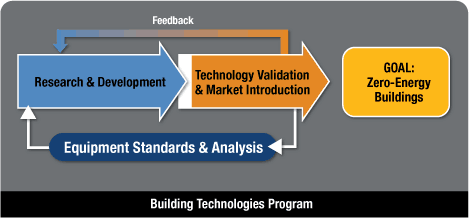The Building Technologies Program is specifically designed and structured to conduct the key activities required to meet its vision, mission, and zero energy goals, which have been developed in an open and consultative process and are linked to the strategic objectives of EERE. On this page you'll find information about the Building Technologies Program's key program areas.
To achieve the goal of net-zero energy buildings, the Building Technologies Program supports research and development of innovative new technologies and better building practices. The program is divided into three interrelated strategic areas designed to overcome technical and market barriers: Research and Development, Equipment Standards and Analysis, and Technology Validation and Market Introduction. The diagram below shows how the three areas work together toward the goal of Zero-Energy Buildings.

Key Program Areas
The Building Technologies Program's funding is organized in five key program areas. Each of these areas contain projects and programs addressing one or more of the strategic elements shown above, and they all work together to improve the efficiency of buildings and the equipment, components, and systems within them. While the three-strategy approach cuts across all of the programmatic elements, each program area has its own unique focus, which is summarized below:
-
Appliances and Commercial Equipment Standards
Working with product manufacturers, designers, utilities, consumers, and other government agencies, this program area develops test procedures and sets minimum efficiency standards for residential appliances and commercial equipment.
-
Building America
This program conducts and supports research, development, and demonstration activities that will produce cost-effective homes that use up to 70% less energy. It partners with more than 270 companies comprised of architects, engineers, builders, equipment manufacturers, material suppliers, community planners, mortgage lenders, and contractor trades.
-
Building Energy Codes
This program supports development of more stringent and easier-to-understand building energy codes; develops downloadable compliance tools and materials; and provides technical and financial assistance to help states adopt, implement, and enforce building energy codes.
-
Commercial Building Energy Alliances
The goal of this program is to minimize the energy use and environmental impact of commercial buildings. The Commercial Building Energy Alliances bring together representatives from a variety of business sectors to work toward this goal. The program currently focuses on retail, commercial real estate, and institutional buildings.
-
ENERGY STAR®
This is a voluntary labeling program sponsored by DOE and the U.S. Environmental Protection Agency (EPA), which helps businesses and consumers easily identify highly efficient products, homes, and buildings that save energy and money, while protecting the environment.
-
High Performance Commercial Buildings
A program working with architects, engineers, builders, contractors, owners, and occupants to optimize building performance, comfort, and savings through a whole-building approach to design and construction.















